Contents
Market Overview
Macro Review: When DM is dovish and EM is hawkish
Developed market central banks in G10 were dovish this week (Fed, Norges and Bank of England), while EM central banks were notably hawkish (Poland and Czech Republic). We have already seen the Reserve Bank of Australia walk back on yield curve control at 0.1% (for the April 2024 benchmark bond), having only reaffirmed the policy tool on October 10th. Meanwhile, the Fed’s FOMC have guided a clear tapering time-line, reducing purchases by $15bn a month with the possibility of increasing the pace. The door is also ajar in terms of a rate lift-off next summer. However, Norges Bank did not follow with a second consecutive hike and the BOE held rates unchanged. The former isn’t too much of a concern given the pre-emptive hike in October and guidance set for December, but the Bank of England was expected to hike by 15bps. The guidance from the BOE was clear: inflation is set to top 5% in 1Q22 but while keeping rates unchanged (voting 7-2) and guiding toward a December hike, they also maintained quantitative easing purchases by a vote of 6-3. The contrast to EM is more striking. Poland hiked rates by 75bps when consensus was only 25bps, while the Czech Republic hiked rates by 125bps against a consensus of 50bps. That is the largest hike since the mid-1990s tantrum and a cumulative hike of 250bps since June takes the policy rate to 2.75%. This shoots the CNB up in ranks in terms of the most hawkish central bank of the year, but perhaps still behind Brazil’s BCB and Russia’s CBR. The strategy of paying 1y1y rates in these markets is still the dominant trade. However, it was the BOE’s decision not to hike rates that caused significant volatility this week in the latest episode of “Quid Games”. The 2yr gilt moved seven standard deviations after tightening 21bps on Thursday, which is the third largest move in over 20yrs. To put that into perspective, we haven’t seen the 2yr gilt move that aggressively since the Pandemic unfolded or since the Brexit result in 2016. In turn, this caused U.S. Treasuries to rally and bull steepen as the 2yr and 5yr tenors tightened. Elsewhere, oil traded soft after President Biden mounted pressure on OPEC+ to raise production, but Azerbaijan’s signal to raise output highlighted further discontent. Needless to say, Covid concerns out of China are hardly helping global supply/demand balances. Away from that, the equity market is clearly ignoring the more uncertain backdrop as the VIX hit a pandemic low (below 15) and the S&P recorded its 63rd all-time high this year.
EM Credit Update
EM credit ended the week up 0.1% as U.S. Treasuries steepened as the front-end of the rates curve tightened 6-7bps. Zambia, Suriname and Turkey outperformed, while Ethiopia, Sri Lanka and Tunisia lagged. The clear victim in EM credit was Chinese property this week, as the sector faced its third worst week in almost six years, down 7.6%. It is worth noting that the sector was down 14.3% in the first week of October, but in this latest episode of volatility we are seeing investment grade issuers come under renewed pressure (as a new development).
The Week Ahead
Further insights into supply chain constraints will be brought to life with the U.S. inflation print next week. On top of that, China’s CPI data is also due, although politics could overshadow it as the Communist Party meets for the first time in more than a year on Monday (albeit as a closed-door session). Interest rate decisions are due from Mexico (4.75%), Peru (1.5%), Romania (1.5%) and Thailand (0.5%). Meanwhile, Argentina, Brazil, Chile, Czech Republic, Hungary, India and Romania will report inflation data. GDP releases out of the UK and Russia will also be worth monitoring, before South Africa’s Medium-Term Policy Budget Statement on Thursday.
Highlights from emerging markets discussed below include: Ecuador’s government faces good odds of passing tax reform by year-end (a key condition for IMF financial support and market confidence), South Africa’s ruling African National Congress loses support in local elections and global emerging markets corporates in focus: Considering COP26 commitments.
Fixed Income
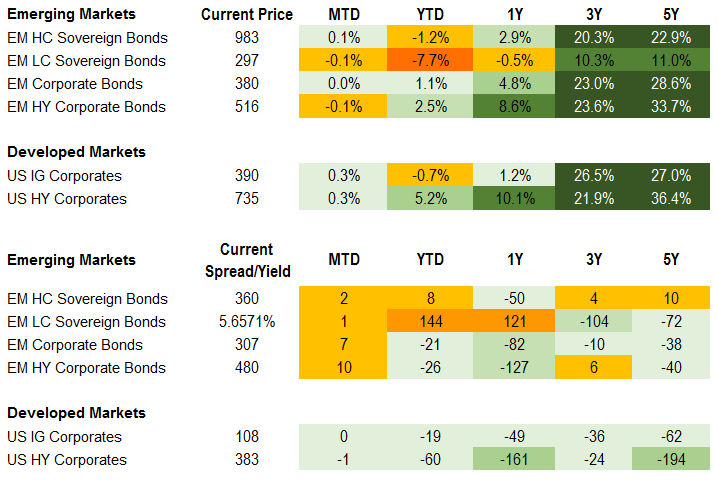
Equities
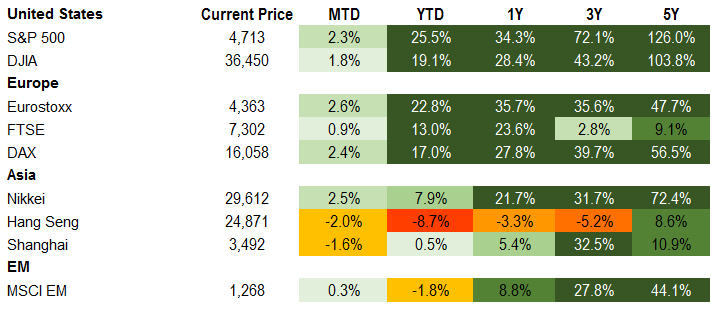
Commodities

Source for data tables: Bloomberg, JPMorgan, Gramercy. EM Fixed Income is represented by the following JPMorgan Indicies: EMBI Global, GBI-EM Global Diversified, CEMBI Broad Diversified and CEMBI Broad High Yield. DM Fixed Income is represented by the JPMorgan JULI Total Return Index and Domestic High Yield Index. Fixed Income, Equity and Commodity data is as of November 5, 2021 (mid-afternoon).
Emerging Markets Weekly Highlights
Ecuador’s government faces good odds of passing tax reform by year-end, a key condition for IMF financial support and market confidence
Event: The National Assembly accepted for discussion the Lasso Administration’s tax reform proposal, after having rejected it on technical grounds back in September.
Gramercy Commentary: Passing tax reform is a key priority for the authorities as they seek to achieve fiscal consolidation targets under Ecuador’s IMF program. President Lasso’s economic team had to repackage its original proposal as a stand-alone piece of legislation after the Assembly refused to consider it on technical grounds when originally presented back in September, raising market concerns about Lasso’s governability prospects. In addition to meeting the Assembly’s technical requirements, the latest version of the tax reform bill is quite progressive in our view, which boosts its chances to appeal to Ecuador’s left-leaning legislature. Furthermore, the Administration appears to have pre-discussed important aspects of the revised tax reform proposal with key opposition leaders in the Assembly, which also increases its approval chances. As such, although there are no guarantees in Ecuadorian politics, we believe the amended tax reform package faces good odds of clearing the Assembly by year-end, catalyzing positive event risk in late 4Q. The tax reform proposal has been assigned to the Assembly’s Economic Development Committee, a body dominated by pro-administration lawmakers, which also bodes well for its legislative prospects. Tax reform approval would keep Ecuador’s IMF program on track and should catalyze momentum for further structural reforms from the Fund’s pipeline in 2022, suggesting market upside for the sovereign bond complex. Meanwhile, street protests against President Lasso’s reforms have been contained and his domestic popularity remains high despite some recent decline.
South Africa’s ruling African National Congress (ANC) loses support in local elections; financing for energy transition positive
Event: With nearly all votes counted, support for the ruling ANC was roughly 46% at the national level marking the first time it dropped below 50% since 1994. The populist and radical EFF (Economic Freedom Fighters) improved its support on the margin to above 10%, while the DA (Democratic Alliance) lost votes largely to smaller parties which in aggregate garnered just over 20% of the national vote, up roughly 10% relative to 2016. Meanwhile, South Africa in partnership with France, Germany, the U.S., UK, and the EU is set to receive $8.5bn in financing over the next three to five years to support the country’s energy transition from coal.
Gramercy Commentary: The vote outcome complicates the 2022 outlook for policy as Ramaphosa gears up to vie for a renewed ANC presidential term at the end of next year. The need for increased coalition governing will slow policy implementation and effectiveness and boosts the chances for social unrest. While we think there is an increased risk for reactive measures to bolster political support, Ramaphosa’s recent political maneuvers, handling of the unrest over the summer and the suspension of Magashule still afford him with a degree of power consolidation heading into the mid-2022 policy conference. Additionally, the announcement of funding for the energy sector is a constructive development for the medium-term and should help contribute to resolution of shortages and inefficiencies at state-run Eskom over time.
Global emerging markets corporates in focus: Considering COP26 commitments
Event: The UN Climate Change Conference (COP26) in Glasgow is ongoing. The focus has been on commitments from nations and corporations to cut emissions and curtail global warming. A number of new commitments have been disclosed in recent days. However, the UN Secretary General (UNSG) remarked that there was still a ‘deficit of credibility and a surplus of confusion.’
Gramercy Commentary: The COP26 summit has shed light on the diverse range of groupings and organizations seeking to address the climate crisis; from global arrangements such as the Glasgow Financial Alliance for Net Zero, to regional ones including the Eastern Tropical Pacific Marine Corridor initiative. On one hand, the plethora of entities focused on the climate crisis is a positive as significant involvement is required to achieve the UN’s stated goals. On the other hand, these varied entities may have equally varied targets and the commitments directly applicable to certain issuers may be unclear. Another potential source of the ‘confusion’ cited by the UNSG may be the differing deadlines for attaining Net Zero emissions. As examples, in the UAE, the target is 2050 while India has chosen 2070 as the deadline year. This may influence decisions made by corporates and by lenders too. Fewer changes might be enacted in the near-term if targets do not need to be met for some time. Definitions are another possible source of ‘confusion’ as what is considered to be ‘Net Zero’ can differ markedly from one corporate to the next. The Science Based Targets Initiative, which has launched the world’s first Net Zero standard, is helping in this regard. However, as best we can make out, nations and corporations have to opt in to this initiative and adherence is largely voluntary. Added to all this, the targets announced have been both qualitative and quantitative. Without clear, measurable (and potentially punitive) consequences tied to missing targets, adherence may be difficult to achieve. Greater involvement of central banks and supervisors, regulators of the world’s financial systems, may mean that lenders’ and investors’ decisions need to increasingly take the climate crisis into account. Over 100 of such regulatory and oversight bodies have signed up to the Network of Central Banks and Supervisors for Greening the Financial System (NGFS). More and more, regulators are requiring financial institutions and others to disclose, and in some cases, limit the climate impact of their operations. Such regulatory changes may have implications for funding, which is clearly vital for many emerging markets corporates. We have already seen some lenders impose limits on fossil fuel-related lending. Over time, there may be fewer funding options for issuers operating in sectors seen as the biggest polluters, especially where such financing is not tied to a transition to greener businesses. As we have discussed on previous occasions, sustainability-linked financing is clearly on the increase and we have seen further evidence of this in recent days, with new funds raised, tied to such initiatives. Concerns about greenwashing have persisted, which is unsurprising. More coordination on standards will be needed if such concerns are to be comprehensively addressed. There are other concerns, especially within emerging markets, that previous financial commitments made by wealthier nations to less wealthy ones to address the effects of the climate crisis have gone unfulfilled. For countries and corporates which contribute the least to the world’s greenhouse gas emissions but have the most to lose from further global warming, this is a source of much frustration. In addition, transitioning away from fossil fuels may be harder for some countries and corporates than others given the dearth of infrastructure to support certain aspects of this (one example is the shift to electric vehicles from fossil fuel-powered ones). Taken altogether, addressing the climate crisis, especially in emerging markets, is a necessary but complex task. It is also a very costly one. However, inaction is costly as well.
Emerging Markets Technicals
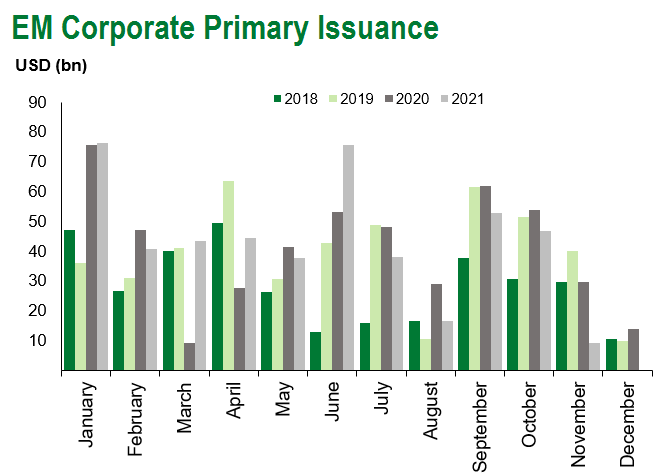
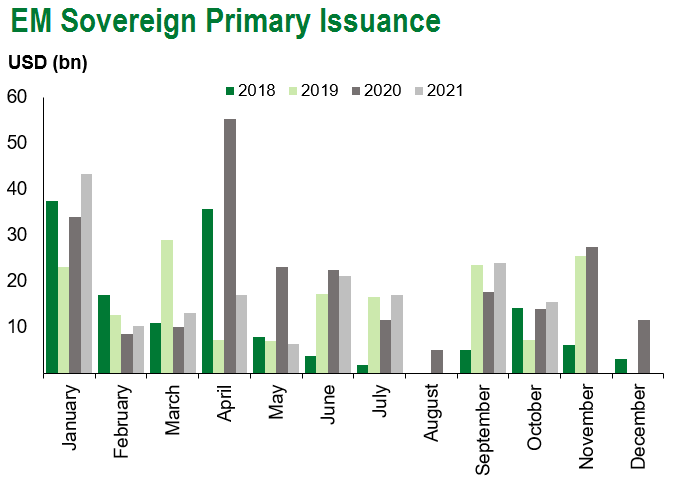
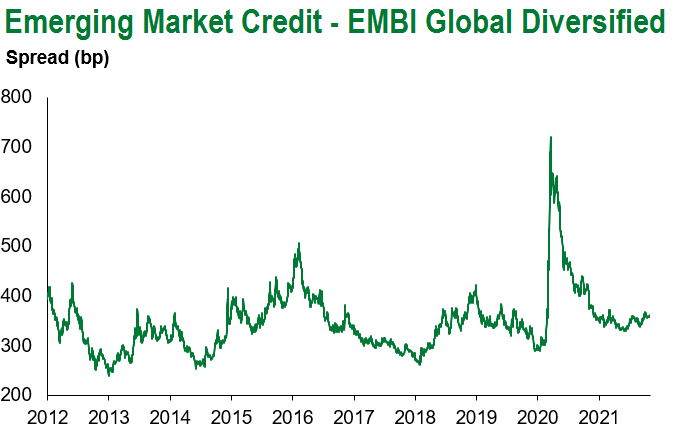
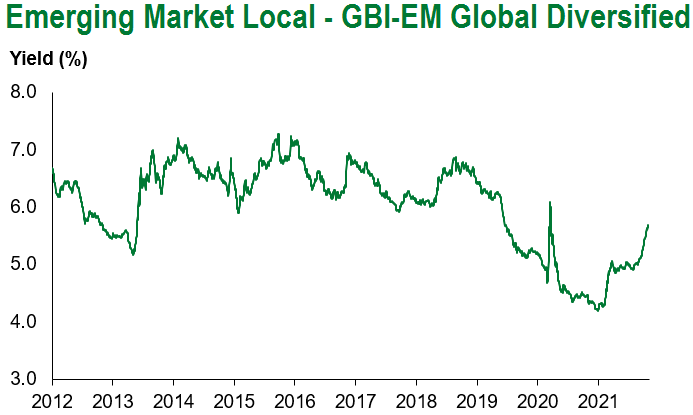
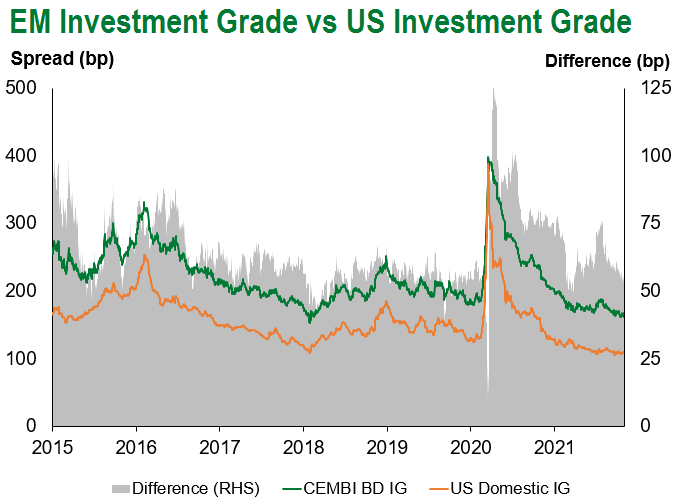
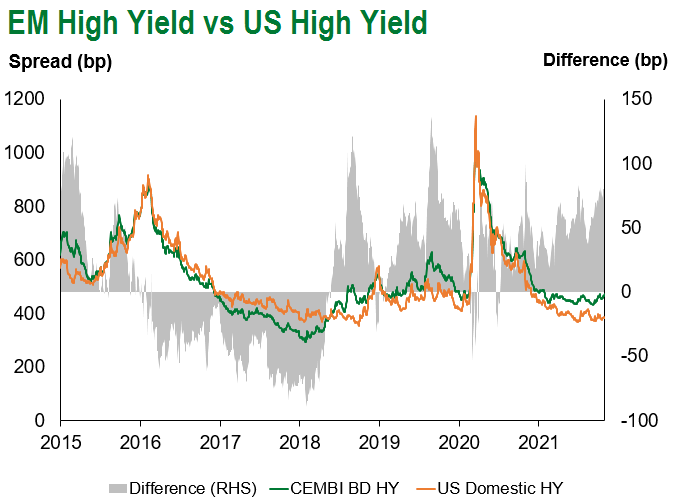
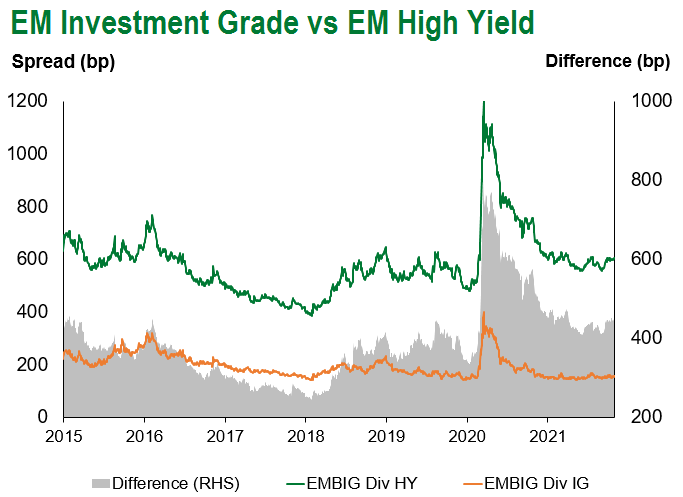
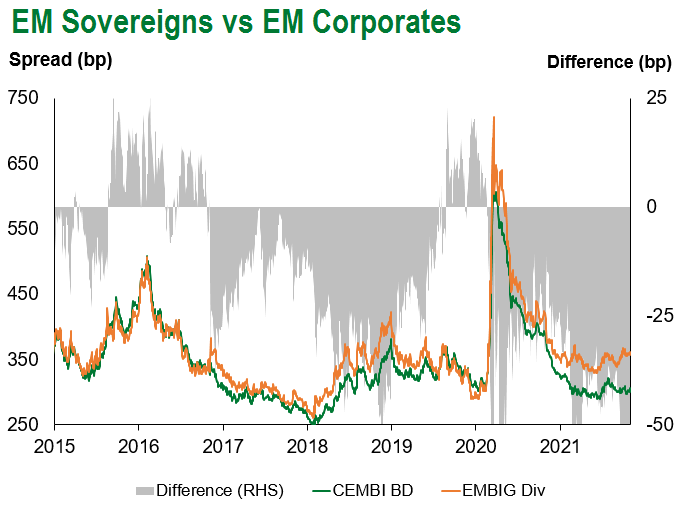
Emerging Markets Flows
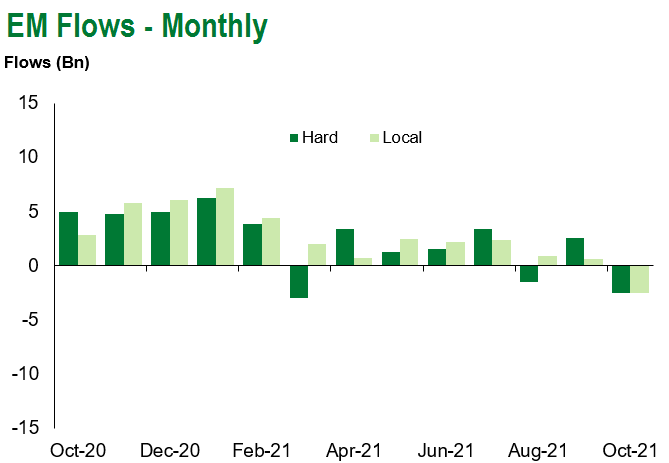
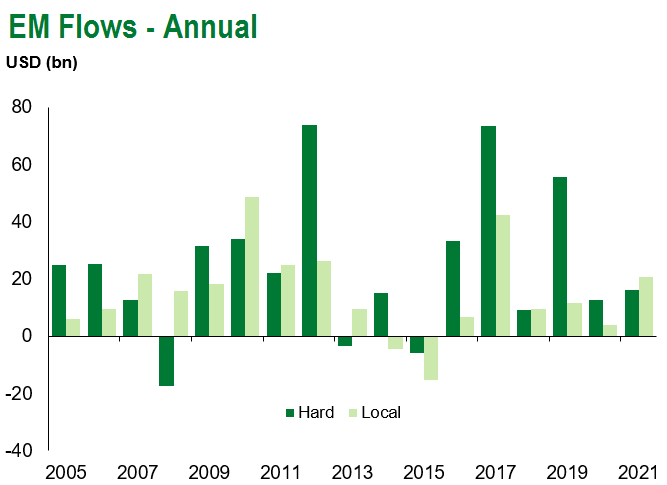
Source for graphs: Bloomberg, JPMorgan, Gramercy. As of November 5, 2021.
COVID Resources
Emerging Markets COVID-19 Case Summary
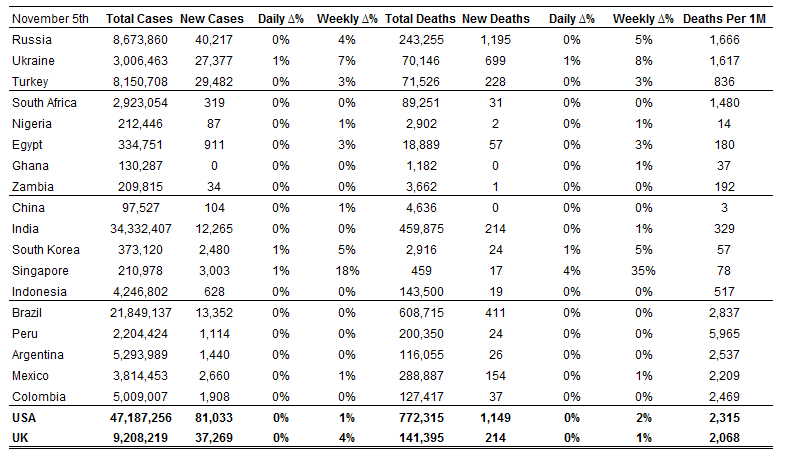
Source: Worldometer as of November 5, 2021.
Additional Crisis Resources:
Johns Hopkins COVID-19 Case Tracker
For questions, please contact:
Kathryn Exum, CFA ESG, Senior Vice President, Sovereign Research Analyst, [email protected]
Petar Atanasov, Senior Vice President, Sovereign Research Analyst, [email protected]
Tolu Alamutu, CFA, Senior Vice President, Corporate Research Analyst, [email protected]
James Barry, Vice President, Corporate Research Analyst, [email protected]
This document is for informational purposes only. The information presented is not intended to be relied upon as a forecast, research or investment advice, and is not a recommendation, offer or solicitation to buy or sell any securities or to adopt any investment strategy. Gramercy may have current investment positions in the securities or sovereigns mentioned above. The information and opinions contained in this paper are as of the date of initial publication, derived from proprietary and nonproprietary sources deemed by Gramercy to be reliable, are not necessarily all-inclusive and are not guaranteed as to accuracy. This paper may contain “forward-looking” information that is not purely historical in nature. Such information may include, among other things, projections and forecasts. There is no guarantee that any forecasts made will come to pass. Reliance upon information in this paper is at the sole discretion of the reader. You should not rely on this presentation as the basis upon which to make an investment decision. Investment involves risk. There can be no assurance that investment objectives will be achieved. Investors must be prepared to bear the risk of a total loss of their investment. These risks are often heightened for investments in emerging/developing markets or smaller capital markets. International investing involves risks, including risks related to foreign currency, limited liquidity, less government regulation, and the possibility of substantial volatility due to adverse political, economic or other developments. The information provided herein is neither tax nor legal advice. Investors should speak to their tax professional for specific information regarding their tax situation.